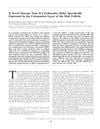Expression of MK6a Dominant-Negative and C-Terminal Mutant Transgenes in Mice Has Distinct Phenotypic Consequences in the Epidermis and Hair Follicle
October 1999
in “
Differentiation
”
TLDR Mutant MK6a transgenes in mice cause blistering, hair loss, and potential human alopecia.
The study investigated the effects of expressing mutant mouse keratin 6a (MK6a) transgenes in mice, focusing on the epidermis and hair follicles. Expression of a dominant-negative MK6a construct (Δ2B-P) in the interfollicular epidermis led to severe blistering and neonatal lethality, indicating that mutations in a human keratin 6 (HK6) isoform might cause similar blistering in humans. Surviving mice with Δ2B-P expression developed severe alopecia, as did mice expressing two different C-terminal mutant transgenes, while a third C-terminal mutant had no effect. Electron microscopy showed that Δ2B-P expression caused keratin filament collapse, whereas the C-terminal mutants led to hair follicle destruction without filament abnormalities. This suggested that the innermost outer root sheath cells are particularly sensitive to altered K6 proteins, implying that mutations in an HK6 isoform in these cells could result in alopecia in humans.
